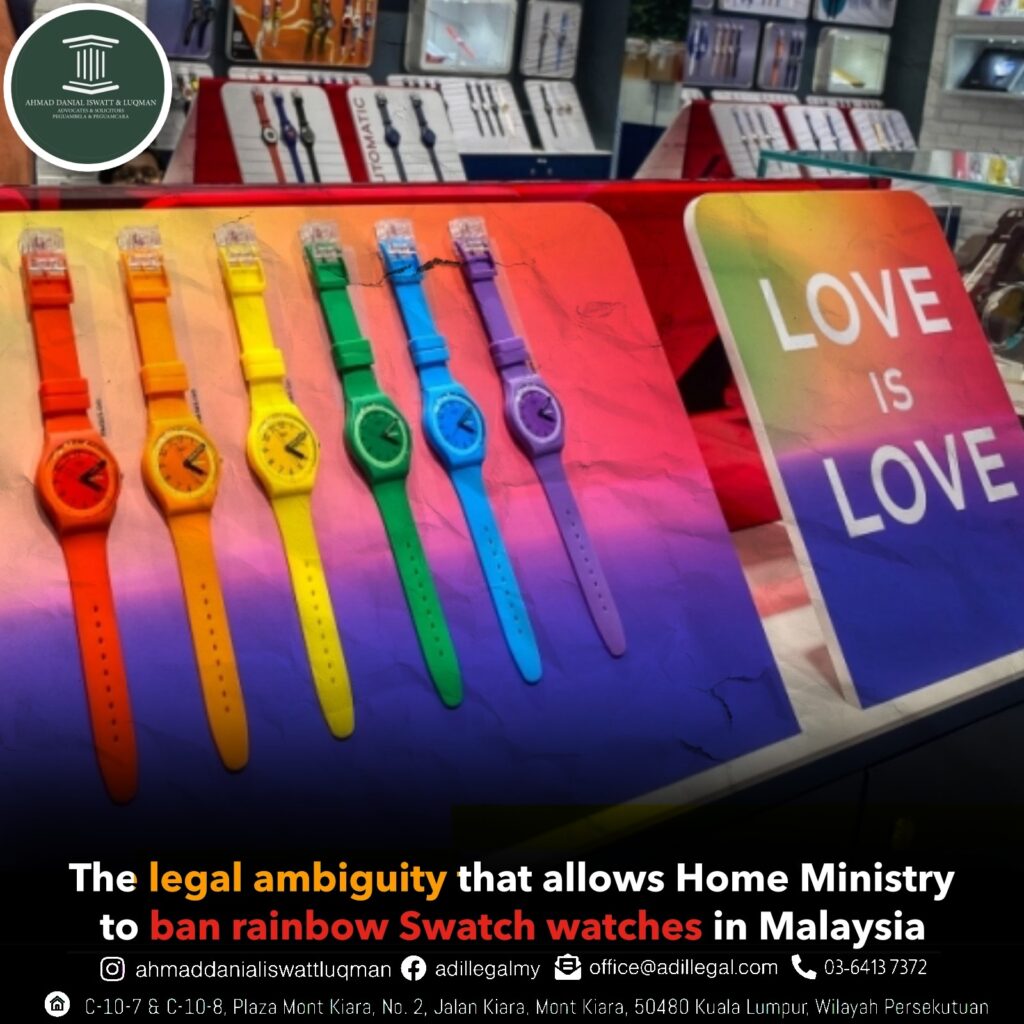
The legal ambiguity that allows the Home Ministry to ban rainbow Swatch watches in Malaysia
Malaysia recently made headlines worldwide after the Home Ministry raided 11 Swatch boutiques in several states and confiscated watches from the brand with alleged elements associated with the Lesbian, Gay, Bisexual, Transgender, Queer and Plus (LGBTQ+) community. As reported by NST, the raids were conducted between 13 and 15 May 2023 at Swatch boutiques nationwide, including Pavilion Kuala Lumpur, One Utama, Sunway Pyramid, Setia City Mall, Mid Valley Megamall, Southkey, Sunway Putra Mall, Sogo KL, Queensbay, Fahrenheit 88 and Suria Sabah.
Meanwhile, 5 other Swatch boutiques were issued a warning, which were the ones in Kuala Terengganu City Centre, AEON Kota Baru, Aman Central Kedah, City Square and Viva City Kuching. It was later revealed that a total of 172 timepieces were confiscated in the raids.
Furthermore, on 10 August, a federal government gazette officially bans the watches in our country and any other publications related to LGBTQ+ in “any form appearing on Swatch watches of any collection including the boxes, wrappers, accessories or any other related things,”. This prohibition was made by Home Minister Datuk Seri Saifuddin Nasution Ismail a day prior to the publishing of the gazette.
Speaking of which, with the gazetting of the prohibition, it is now an offence for anyone in Malaysia to possess the banned watches “without lawful excuse”. If convicted, one may face up to 3-year jail or an RM20,000 fine or both under the Printing Presses and Publications Act 1984 [Act 301], which is the same law used to prohibit the Swatch timepieces.
So, how can a law relating to printing presses and publications be used to prohibit watches in our country? More importantly, is the whole act even legal?
Well, join us as we break down the relevant laws and their interpretations below.
Printing Presses and Publications Act 1984 [Act 301]
The prohibition of the Swatch timepieces with LGBTQ+ elements was made under the Printing Presses and Publications (Prohibition of Undesirable Publications) Order 2023 below:
Basically, the order is the Home Minister exercising his powers as conferred by Section 7 of Act 301. Moreover, as the name of the order would suggest, Section 7 of the said Act deals with “undesirable publications”, which in the case of the Swatch watches, is something that is “likely to be prejudicial to morality”.
So, why are the Swatch timepieces considered “publications”? Well, to understand the connection, we must first explain what Act 301 is all about.
An Act to regulate the use of printing presses and the printing, importation, production, reproduction, publishing and distribution of publications and for matters connected therewith in Malaysia, Act 301, among other things, allows the Home Ministry to prohibit the import and distribution of “undesirable publications” or to seize such banned publications. Accordingly, for the Home Ministry to exert its powers as per Act 301 on an item, it must fall under the category of “publication”.
In relation to that, the Act prescribes a rather wide and ambiguous definition for what is considered a publication. This is governed under Section 2 of Act 301 below:
Applied to the subject matter at hand, the watches can be deemed as a publication simply for what is printed on them as per the definition under (b) above. For example, if the Swatch timepieces have the words LGBTQ+ on them, they may be considered a publication under the interpretation of Act 301.
Moreover, even if there are no written words, Section 2 of Act 301 also considers “anything which by its form, shape or in any manner is capable of suggesting words or ideas” as a publication as per the definition under (c) above. For example, the rainbow colours can be argued to suggest the words or ideas of LGBTQ+ due to their association with the community.
Hence, the prohibition on the Swatch timepieces can be deemed as legal due to the wide definition and ambiguity of what is considered a publication under Act 301. However, this is not set in stone as Swatch can apply for a judicial review (which they have already done) to argue that the timepieces in question are not publications.
Furthermore, Swatch can also argue that the (b) and (c) definitions under Section 2 of Act 301 are unconstitutional as per Article 10 of the Federal Constitution which guarantees the right to freedom of expression. Even if Article 10(2)(a) of the Federal Constitution permits imitations on the grounds of public order or morality, such restrictions should remain within reasonable bounds, which the actions by the Home Ministry had arguably crossed.
Therefore, the final say on whether the timepieces are indeed publications as per Act 301 would be by the courts.
So, were the raids and seizures on the Swatch stores lawful?
With that in mind, the actions of the Home Ministry in raiding the stores and seizing the watches are actually unlawful. This is because the ministry didn’t follow the proper procedures and framework as prescribed by Section 7 of Act 301.
Specifically, the Home Ministry didn’t adhere to Section 7(1) of the Act which required a gazette on the banning of the publication first below:
Given that the federal government gazette was only made on 10 August, nearly 3 months after the raids were conducted, it is clear that the Home Ministry didn’t follow proper procedures when exerting its powers under Act 301. Hence, the court can quash the decision by the Home Ministry in confiscating the watches by Certiorari and order a return of the watches by Mandatory Injunction. Furthermore, Swatch may also request a declaration that the watches in question are not a publication under Act 301.
Moving forward, it’d be interesting to see the decision by the High Court in its scheduled hearing for Swatch’s application for leave for judicial review. Set for 23 August 2023, all eyes would be on the case, intently watching the next chapter of this colourful watches saga.
For more insights into the Malaysian legal system such as this, do make sure to follow us on Facebook and Instagram or visit our official website. You can also read our articles on the popular Malaysian news aggregator app Newswav here.






